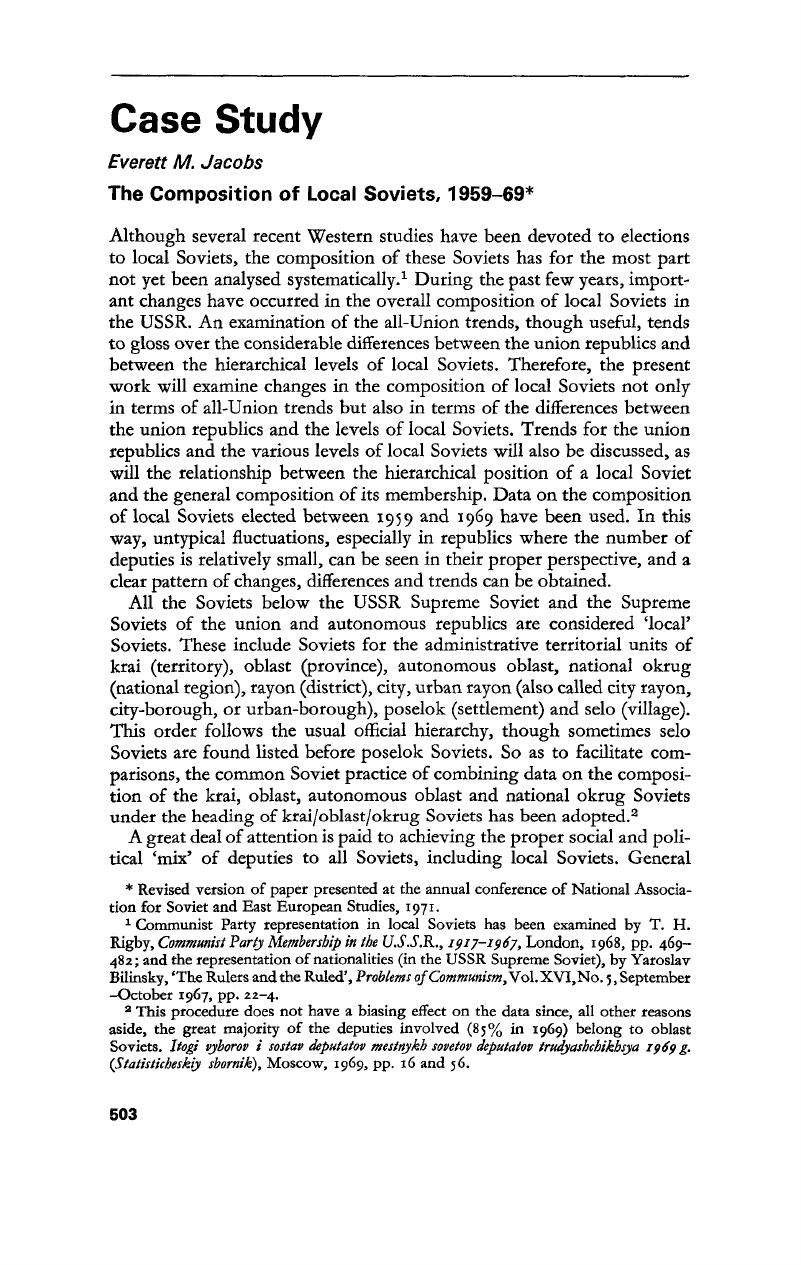Published online by Cambridge University Press: 28 March 2014

1 Communist Party representation in local Soviets has been examined by Rigby, T. H., Communist Party Membership in the U.S.S.R., 1917–1967, London, 1968, pp. 469–482 Google Scholar; and the representation of nationalities (in the USSR Supreme Soviet), by Bilinsky, Yaroslav, ‘The Rulers and the Ruled’, Problems of Communism, Vol. XVI, No. 5, 09‐10 1967, pp. 22–4.Google Scholar
2 This procedure does not have a biasing effect on the data since, all other reasons aside, the great majority of the deputies involved (85% in 1969) belong to oblast Soviets. Itogi vyborov i sostav deputatov mestnykb sovetov deputatov trdyasbcbikbya 1969 g. (Statisticbeskiy sbornik), Moscow, 1969, pp. 16 and 56.
3 Churchward, L. G., ‘Soviet Local Government Today’, Soviet Studies, Vol. XVII, No. 4, 04 1966, pp. 451–2Google Scholar. For further details on the selection and nomination of candidates, see the present author's ‘Soviet Local Elections: What They Are and What They Are Not’, Soviet Studies, Vol. XXII, No. I, 07 1970, pp. 65–7.Google Scholar
4 ‘Vybory v mestnye sovety’, Partiinaya zbizn’, No. 3, February 1969, p. 6.
5 Grigorev, V. K., Vybory v mestnye sovety deputatovtrdyasbcbikhsya, Moscow, 1969, p. 37.Google Scholar
6 Arutyunyan, N. Kh., Partiya i sovety, Moscow, 1970, pp. 32 and 34.Google Scholar
7 Swearer, Howard R., ‘The Functions of Soviet Local Elections’, Midwest Journal of Political Science, Vol. V, No. 2, 05 1961, p. 134.Google Scholar
8 In 1970, 65% of the population of Estonia, and 62% of the population of Latvia lived in urban areas (the highest proportions within the USSR). Also, in 1959. 44.9% of the women in Estonia, and 44.4% of the women in Latvia were engaged in employment (the third and fourth highest proportions in the USSR). See Chislennost', razmesbch‐eniye, vozrastnaya struktura, uroven obrazovaniya, natsionalnyy sostav, yaz yki i istacbniki sredstv susbcbestvovaniya naseleniya SSSR. Po dannym Vsesoyuznoiy perepisi naseleniya 1970 goda, Moscow, 1971, p. 9, and R. A. French, ‘Recent Population Trends in the USSR’ in Michael Kaser (ed.), St. Antony's Papers No. 19 (Soviet Affairs, No. 4), London, 1966, p. 81.
9 In 1955, the figure was 46.6%; in 1957, 45.4%. (Swearer, op. cit., p. 139.)
10 Rigby, op. cit., pp. 476–8, reported that ‘the rise in party representation in local soviets continued fairly generally for some years after 1947, but began to be reversed in the late 1950's’. Not having the 1969 and 1971 data available, he thought that the increased party representation in local Soviets in 1967 ‘evidently reflected a decision to resume the earlier trend towards higher party saturation of these bodies’. His view of the overall trend of party representation for the period 1947 to 1967 is that there had been a levelling up of party representation in the Soviets as between the various republics, in contrast to the present author's view, for the period 1959 to 1971, that there had been a levelling down as well as a levelling up.
11 Ibid., p. 478. Rigby gives the figures for party representation in the Ukraine's local Soviets as 31.8% in 1947–48, 34.0% in 1950, 36.9% in 1953, 40.7% in 1955, and 42.5% in 1957.
12 The correlations were as follows: 1959, ‐0.74, and 1961, ‐ 0.66 (both Significant at the 1% level); 1963, −0.60, and 1965, −0'62 (both significant at the 2% level); 1967, –0'33, 1969, +−0'13, and 1971 (preliminary figures), + 0.04 (none of which are statistically significant).
13 In 1965, the figure was 32%; in 1968, 29% (Narodnoye khozvaystvo SSSR v 1969g., Moscow, 1970, p. 527, hereafter abbreviated as Narkboz 1969).
14 Narkboz 1969, op. cit., p. 527. Also, the party is undoubtedly reluctant to make large reductions in the representation of various elite white‐collar occupational groups to improve the representation of comparatively low‐status occupational groups.
15 The Jewish Autonomous Oblast has been created as an official national area for the Jews, but its population was less than 9% Jewish in 1959. ItogiVsesoyuznoy pere‐pisi naselenya 1959 goda: SSSR. (Svodnyy tom), Moscow, 1962, p. 204.
16 This is clear from the data on national representation, broken down by republic, for the 1959 and 1961 local elections. Such information is unavailable for subsequent elections.
17 The same may be said for Tatars and Jews. See Cbislemst'…nareleniya SSSR, op. cit., pp. 26–32.
18 Ibid.
19 See Conquest, Robert, Tbe Nation KiIlers: The Soviet Deportation of Nationalities, London, 1970, pp. 139–63.Google Scholar
20 Bilinsky, op. cit., p. 24.
21 Conquest, op. cit., pp. 139–63 and 180–7. Data are unavailable to compute separate IRs for Crimean and Kazan Tatars or Volga and Baltic Germans. Neither the Kazan Tatars nor the Baltic Germans were involved in the changes and may have a higher IR than their deported brethren.
22 Hill, Ronald J., ‘Continuity and Change in USSR Supreme Soviet Elections’, Britisb Journal of Political Science, Vol. II, Part I, 1972, p. 62.Google Scholar Hill finds that there is a bias in the re‐election process in Supreme Soviet elections against agricultural and industrial workers, teachers, medical workers, and transport workers, and in favour of party officials, state officials, officers of the armed forces, and ‘probably management generally’.
23 In 1969, 1.3% of all deputies were elected to krai/oblast/okrug Soviets; 10.9% to rayon Soviets; 11.8% to city Soviets; 4.4% to urban rayon Soviets; 9.2% to poselok Soviets; and 62.3% to selo Soviets (Itogi vybarov… 1969. op. cit., pp. 16–17).
24 Jacobs, op. cit., pp. 72–3.
25 As Rigby states., ‘because party membership is symbolic of authority, the more authoritative and august the body, the higher the level of party membership felt to be appropriate to it’ (op. cit., p. 479).
26 Churchward, op. cit., p. 451.